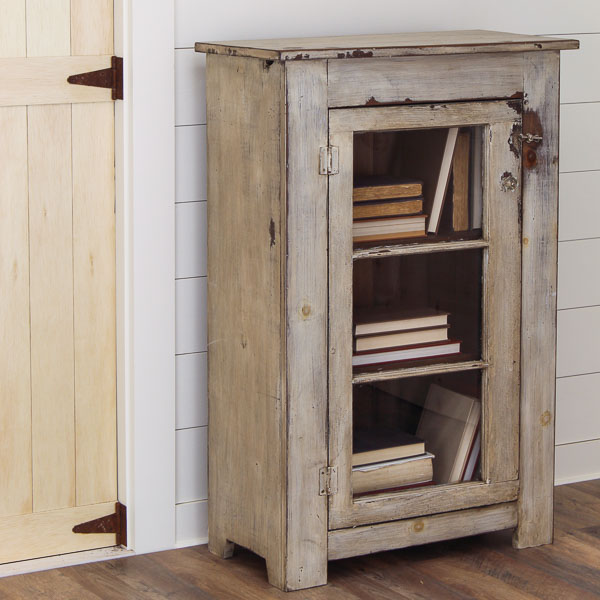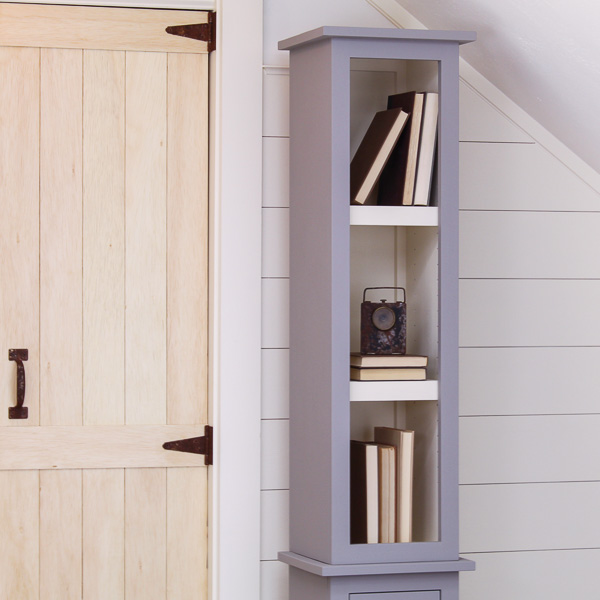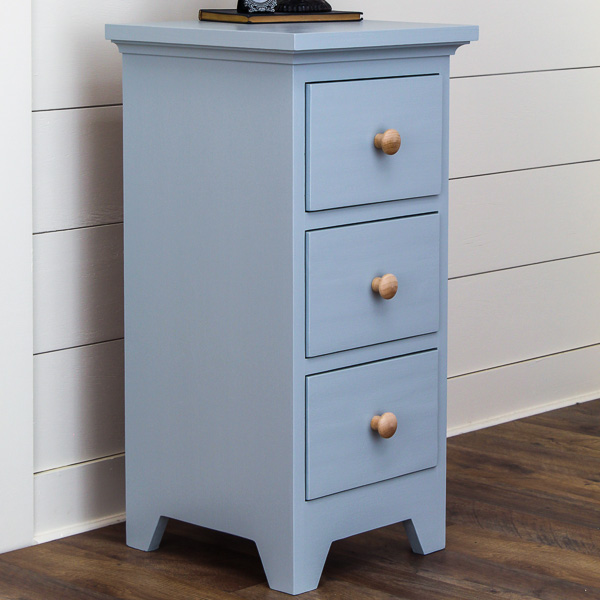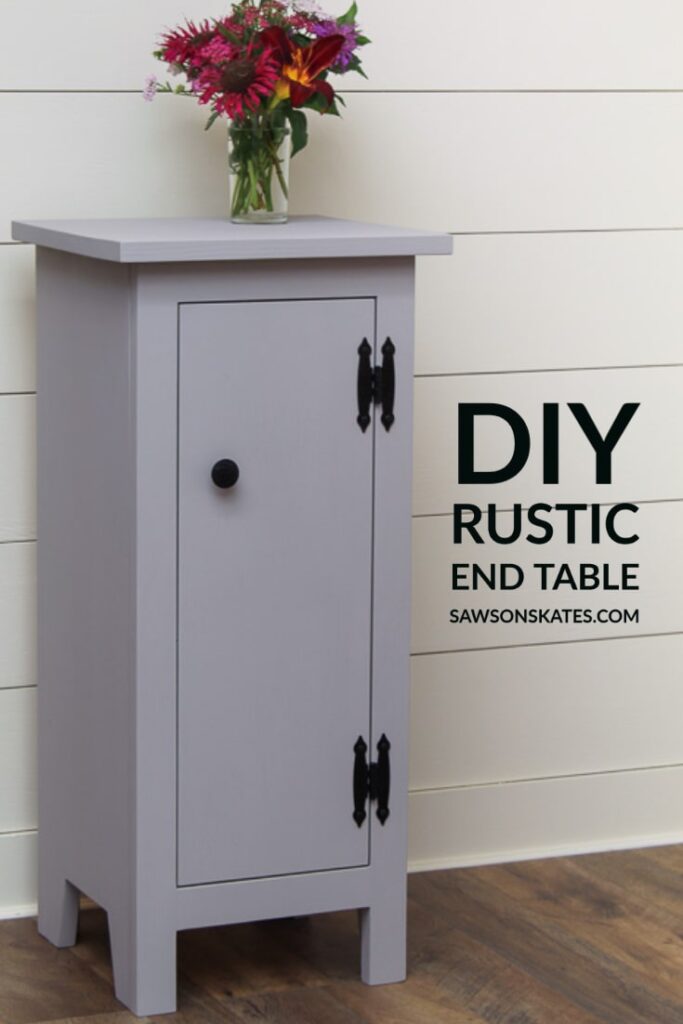Rustic DIY End Table
Keep clutter out of sight! This small DIY end table adds rustic-style storage to any space. It’s easy to make with a few common tools and these free plans.
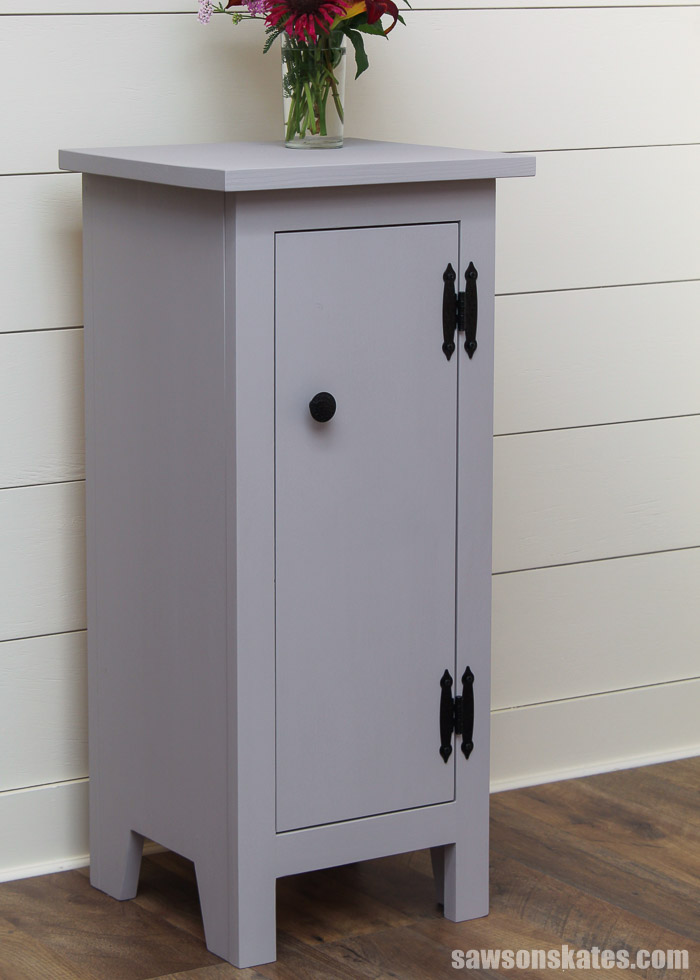
DIY End Table with Storage
Add rustic-style storage to your home with this easy-to-make DIY end table.
This simple do-it-yourself project is the perfect size to use as an end table next to a couch or chair, as a nightstand in the bedroom, or extra storage in the bathroom or kitchen.
Up top, there’s room for a lamp, a place to set a drink, or rest a phone, tablet, or your favorite book.
Down below, the enclosed storage area keeps clutter hidden out of sight.
Behind the door, two adjustable shelves can be positioned to stash magazines and books, hide remotes, and more.
Get the free, easy-to-follow plans and build one (or two!) today.
This tutorial contains affiliate links to supplies and tools. Purchases made using these links help support the Saws on Skates website and allows me to share more projects and tips with you. There is no cost to you for using these links. Visit my site policies for more information.
Before we get into how to make a rustic DIY end table, be sure to click the subscribe button at the bottom of this page to sign up for my FREE weekly newsletter loaded with helpful pocket hole tricks, space-saving workshop ideas, clever DIY tips and more!
Table of Contents
- What Tools Do You Need?
- What Kind of Wood Do You Need?
- How Do You Make Adjustable Shelves?
- How Do You Finish the End Table?
- Where to Use This End Table
- How to Make a DIY End Table
- Get the Free Printed Plan
What Tools Do You Need?
This rustic end table is an easy project for DIYers of any skill level.
The table can be made in a weekend using basic woodworking skills, and just a few common woodworking tools. Tools like a miter saw, pocket hole jig, a drill, and a jig saw.
Related: 7 Miter Saw Tricks Every DIYer Should Know
We can use any pocket hole jig to drill the pocket holes. The inexpensive, user-friendly Kreg Jig 320 is a great choice to drill the pocket holes for this project.
Related: How to Use a Kreg Jig 320
The jig saw will be used to cut the leg area on the sides of the table. It can also be used to make a few other cuts.
I used a table saw to cut the back panel for my project, but these cuts can easily be made with a jig saw or a circular saw instead.
Related: 4 Ways to Make Straight Cuts with a Circular Saw
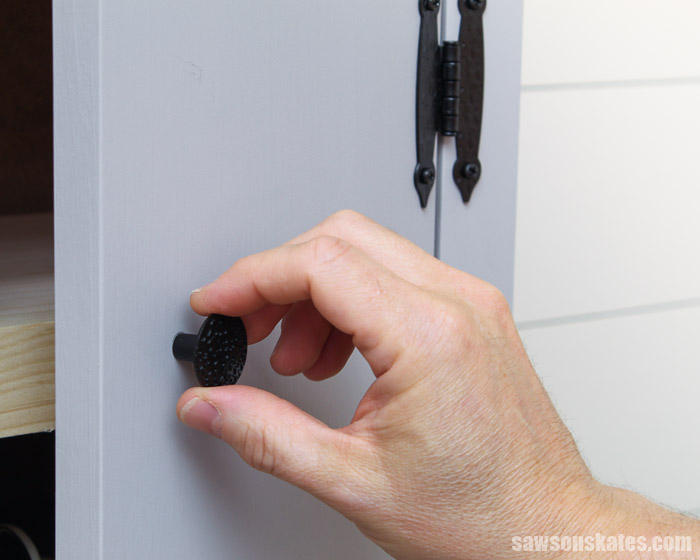
I used a shelf pin jig to add adjustable shelves to this project. If you don’t have a shelf pin jig, you can build this table with fixed shelves instead.
Related: How to Use a Shelf Pin Jig
It’s also important to have a right angle drill attachment. Some of the pocket hole locations on this project are almost impossible to reach with a traditional driver.
A right angle drill attachment is the perfect tool to drill in a tight spot or to drive screws in hard-to-reach places.
Related: Why You Need a Right Angle Drill Attachment
Back to Table of ContentsWhat Kind of Wood Do You Need?
This easy-to-make end table can be made with just about any type of wood. I used common pine to build mine. Pine is inexpensive and easy to work with. I purchased the pine 1×2s, 1×3s, 1×4s at my local home improvement store.
I also used a small piece of ⅛” hardboard for the back panel of the cabinet. Hardboard is usually located near the plywood in home improvement stores.
Related: Beginner’s Guide to Wood Sizes
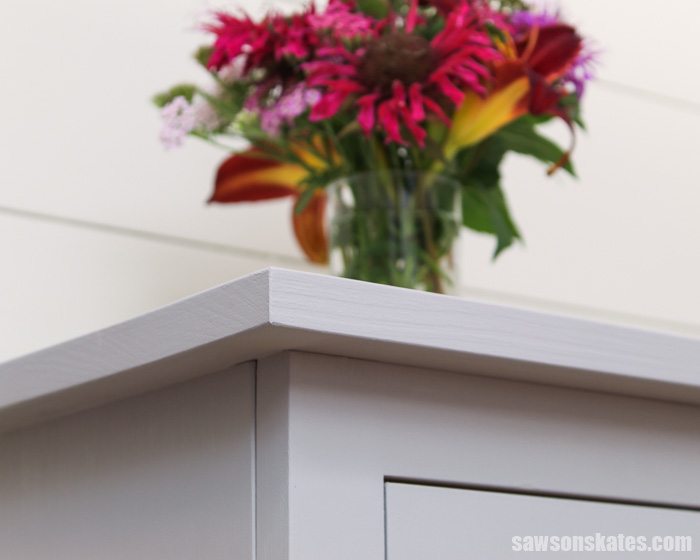
How Do You Make Adjustable Shelves?
I used my Kreg Shelf Pin Jig to drill shelf pin holes in the sides of the cabinet. Shelf pins are then installed in the holes to support the shelves.
The adjustable shelves can be positioned to store magazines, books, remotes, and more.
The jig is simple to use. Just clamp the jig to the board and drill through the guides in the jig. That’s it!
Related: How to Use a Shelf Pin Jig
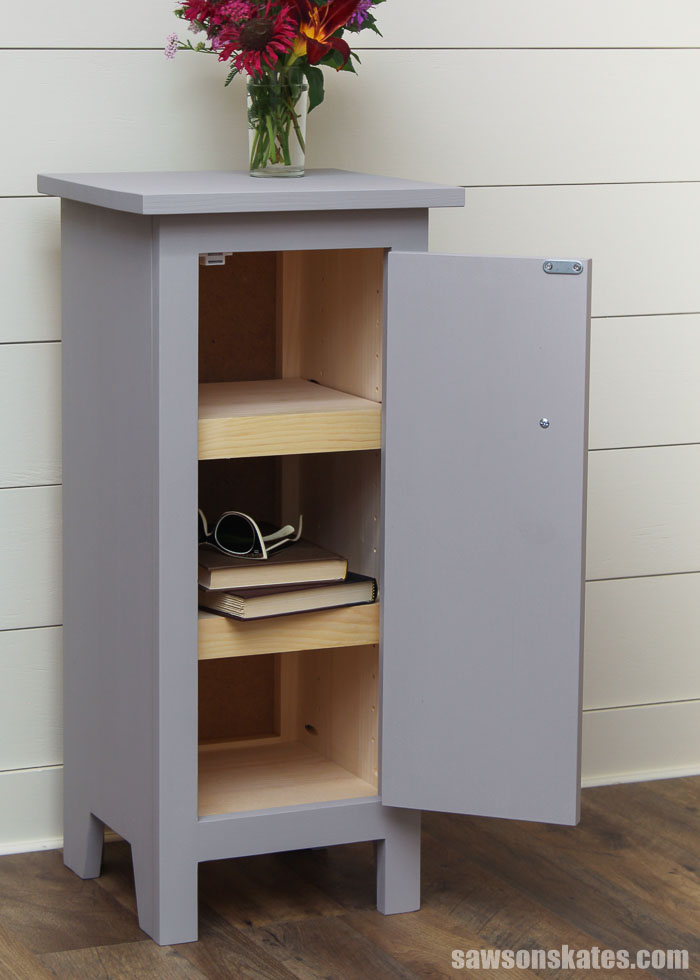
How Do You Finish the End Table?
This rustic end table could be finished in a variety of ways. It could be left natural, painted, stained, or a combination of paint and stain.
I chose to paint my table. First, I applied a coat of primer and then painted the table with two coats of Behr “City of Bridges”.
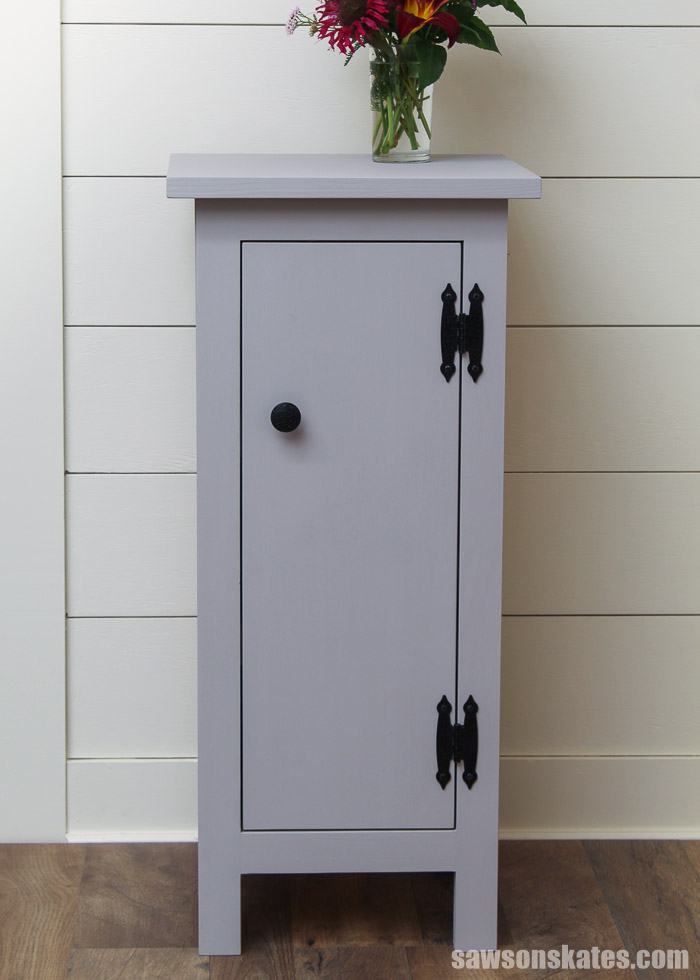
Where to Use This End Table
- Entryway
- End table next to a couch or chair
- Nightstand or bedside table
- Bathroom
- Kitchen
Rustic DIY End Table
Printed Plan
- Get the FREE plan here (includes detailed instructions, measurements, and bonus tips).
Supplies
- Wood (per printed plan)
- 1-¼” Coarse-Thread Pocket Screws
- 1-¼” Fine-Thread Pocket Screws
- ½” Pin Nails or Brad Nails
- Wood Glue
- Knob (I used this one)
- Hinges (I used these)
- Magnetic Catch
- Shelf Pins (I used these)
Tools
- Tape Measure
- Drill
- Kreg Jig
- Kreg Multi-Mark
- Miter Saw
- Jigsaw
- (Optional) Table Saw or Circular Saw
- Shelf Pin Jig
- Hammer or Nail Gun
- Right Angle Drill Attachment
- Countersink Drill Bit Set
Step 1. Make the Sides
Cut 6 pieces of wood to length for the sides. Apply glue and clamp to form 2 side panels.
When the glue is dry, layout the location of the legs.
Next, in the leg area that will be removed, drill a hole near the corner of each leg. These holes will make it easier for the jig saw to turn the corners. Use a jig saw to cut out the leg area.
Then, drill pocket holes in each side panel.
Use a Kreg Shelf Pin Jig to drill holes for the adjustable shelves in the sides. To help position the shelf pin jig, I clamped a piece of scrap wood to the bottom of the side panel. Then, I positioned the jig on the scrap wood, clamped the jig to the side and drilled the shelf pin holes.
Related: How to Make Adjustable Shelves with a Shelf Pin Jig
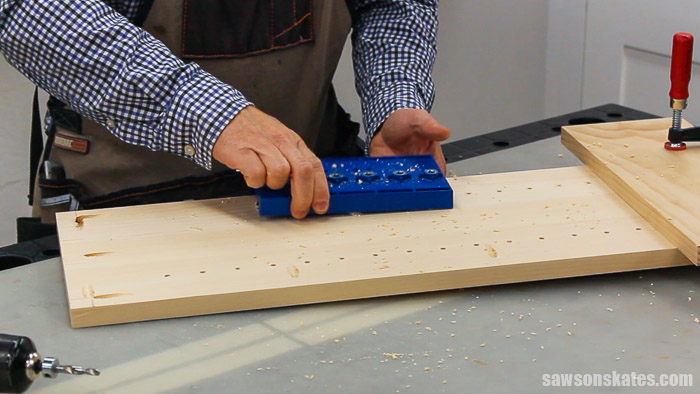
Optional: You could make fixed shelves instead of adjustable shelves. To use fixed shelves instead of adjustable shelves, make additional bottom panels (see Step 2) to use as shelves. Position at the height you want the shelves in the cabinet and attach using pocket screws.
Step 2. Attach the Bottom
Cut 3 pieces of wood to length for the bottom. Apply glue to the edges and clamp to form a panel. When the glue is dry, drill pocket holes in each side.
To help with positioning the bottom, I clamped a piece of scrap wood to the bottom of each side panel.
Apply glue to the edges of the bottom, position on top of the scrap wood, and clamp. Attach using pocket screws and a right angle drill attachment.
Step 3. Attach the Face Frames
Cut 4 pieces of wood to length for the legs. Cut 4 pieces of wood to length for the rails and drill pocket holes in each end.
To help with positioning the bottom rail, I cut 2 pieces of scrap wood and clamped it to the bottom of each leg.
Apply glue to the rails, clamp to the legs, and attach using fine-thread pocket screws.
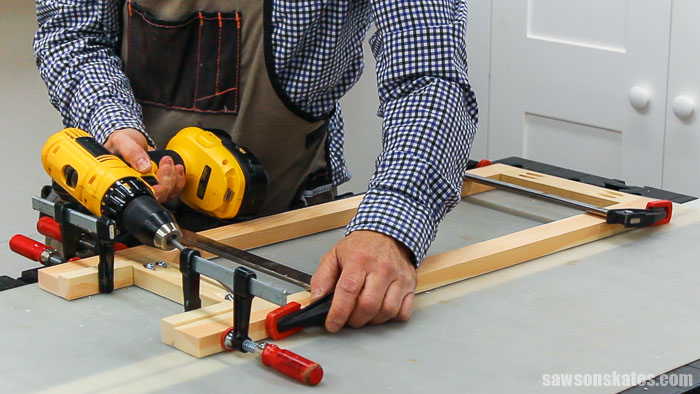
Next, apply glue to the edges of the side panels, position the frame on the case, and clamp.
Attach using pocket screws. Repeat for the second frame.
Step 4. Attach the Back
Cut 1 piece of hardboard to size for the back. I used my table saw to cut this piece, but you could also use a circular saw or a jig saw.
Related:
I positioned the back on the case, traced around the edge with a pencil and then removed the back. Next, I applied glue within the pencil lines and placed the back in position.
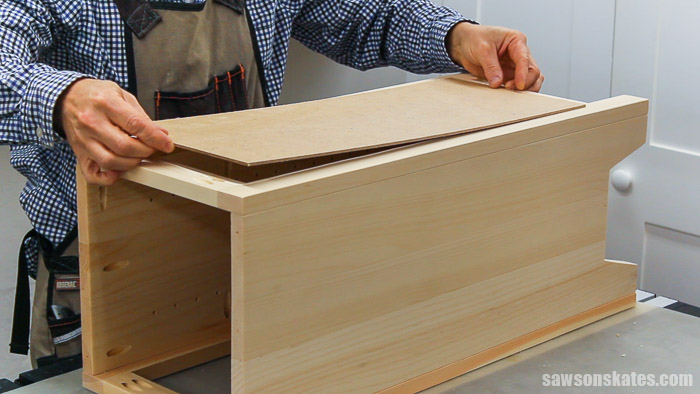
I used my pin nailer and ½” pin nails to hold the back in place, but you could also attach the back without nails. Just clamp the back to the case and allow the glue to dry.
Step 5. Attach the Mounting Block
This mounting block will be used to attach a magnetic catch to keep the door closed.
Cut 1 piece of wood to length for the mounting block.
Position the mounting block on the end of the rail (on the opposite side of where you plan to attach the hinges) and attach using wood screws.
Step 6. Attach the Top
Cut 4 pieces of wood to length for the top. Apply glue to the edges, and clamp to form a panel.
When the glue is dry, position the top on the case, and attach using pocket screws.
Step 7. Attach the Door
Cut 3 pieces of wood to length for the door. Apply glue to the edges, and clamp to form a panel.
Next, attach the door to the case with hinges. Then, attach the magnetic catch to the mounting block using the screws included with the catch.
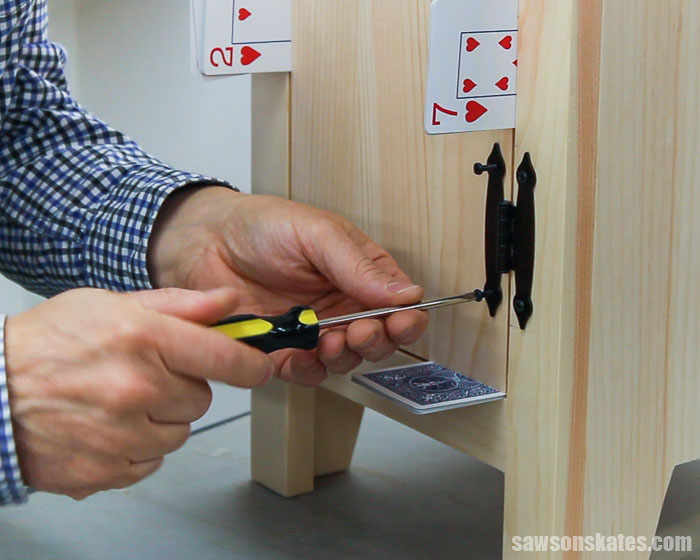
Step 8. Make the Shelves
Cut 8 pieces of wood to length for the shelves.
Apply glue and clamp to form a shelf. Repeat for the second shelf.
Step 9. Finish the End Table
This DIY end table could be finished in a variety of ways. It could be left natural, painted, stained, or a combination of paint and stain.
I applied a coat of primer and then painted my table with two coats of Behr “City of Bridges”.
Final Thoughts
Add rustic-style storage to your home with this easy-to-make DIY end table. This simple project is the perfect size to use as an end table, nightstand, or extra storage in the bathroom or kitchen.
Get the free plan (including the detailed instructions and measurements) now!
Thank you for stopping by. If you enjoyed this tutorial, would you please take a moment and pin it to Pinterest? I’d really appreciate it!

